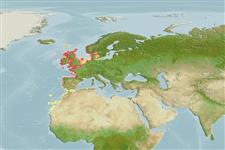Actinopterygii (ray-finned fishes) >
Syngnathiformes (Pipefishes and seahorses) >
Syngnathidae (Pipefishes and seahorses) > Syngnathinae
Etymology: Nerophis: Greek, neros, nearos = youhtfull appearance + Greek,ophis = serpent (Ref. 45335).
Environment / Climate / Range
Ecology
Marine; demersal; depth range 0 - 30 m (Ref. 6733). Temperate, preferred ?; 63°N - 21°N, 18°W - 13°E
Eastern Atlantic: southern Norway, Kattegat and British Isles to Rio de Oro in Western Sahara.
Size / Weight / Age
Maturity: Lm ? range ? - ? cm
Max length : 15.0 cm TL male/unsexed; (Ref. 6733); 17.0 cm TL (female)
Short description
Morphology | Morphometrics
Pectoral and caudal fins absent. Anal opening below front end of the dorsal fin. With 17-19 body rings. The snout is short and bent upwards (Ref. 35388).
Intertidal to about 30 m (Ref. 6733), among rocks or holdfasts and lower branches of algae (Ref. 4509). Spawn in the summer months. Become sexually mature at an age of 2 years. Feed on small crustaceans and fish fry (Ref. 35388). Larvae are attached to the ventral surface of the males (Ref. 42359). Ovoviviparous (Ref. 205). Parental care is exclusively paternal (Ref. 42359). The male carries the eggs in a brood pouch which is found under the tail (Ref. 205).
Males brood their offspring attached to their flattened ventral surface. All throughout the gestation period, parental care is strictly paternal. No further care is needed once the newborn juveniles become free-swimming (Ref. 42359).
Sex roles are reversed in this species. The females are the courting sex and change color more intensely than the males (Ref. 42363). Unlike in other pipefishes, the courtship ritual takes place in close contact with the substratum which may characterise adaptation to typical intertidal conditions (Ref. 42363).
Dawson, C.E., 1990. Syngnathidae. p. 658-664. In J.C. Quero, J.C. Hureau, C. Karrer, A. Post and L. Saldanha (eds.) Check-list of the fishes of the eastern tropical Atlantic (CLOFETA). JNICT, Lisbon; SEI, Paris; and UNESCO, Paris. Vol. 2. (Ref. 4509)
IUCN Red List Status (Ref. 115185)
CITES (Ref. 94142)
Not Evaluated
Threat to humans
Harmless
Human uses
More information
ReferencesAquacultureAquaculture profileStrainsGeneticsAllele frequenciesHeritabilityDiseasesProcessingMass conversion
Tools
Special reports
Download XML
Internet sources
